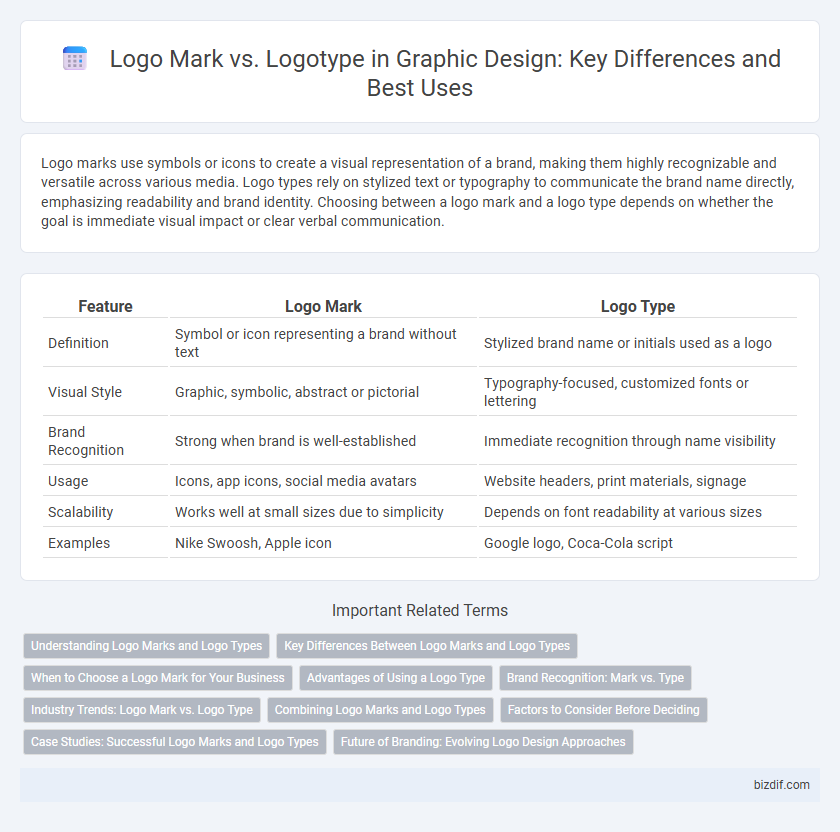Logo marks use symbols or icons to create a visual representation of a brand, making them highly recognizable and versatile across various media. Logo types rely on stylized text or typography to communicate the brand name directly, emphasizing readability and brand identity. Choosing between a logo mark and a logo type depends on whether the goal is immediate visual impact or clear verbal communication.
Table of Comparison
| Feature | Logo Mark | Logo Type |
|---|---|---|
| Definition | Symbol or icon representing a brand without text | Stylized brand name or initials used as a logo |
| Visual Style | Graphic, symbolic, abstract or pictorial | Typography-focused, customized fonts or lettering |
| Brand Recognition | Strong when brand is well-established | Immediate recognition through name visibility |
| Usage | Icons, app icons, social media avatars | Website headers, print materials, signage |
| Scalability | Works well at small sizes due to simplicity | Depends on font readability at various sizes |
| Examples | Nike Swoosh, Apple icon | Google logo, Coca-Cola script |
Understanding Logo Marks and Logo Types
Logo marks are graphic symbols or icons that represent a brand visually without relying on text, often designed to create instant recognition through unique shapes or imagery. Logo types, also known as logotypes or wordmarks, consist solely of stylized text, typically the company name, crafted with specific typography to convey personality and tone. Understanding the distinction between logo marks and logo types is essential for designing cohesive brand identities that effectively communicate a company's values and enhance memorability.
Key Differences Between Logo Marks and Logo Types
Logo marks are graphic symbols or icons that visually represent a brand without using words, focusing on imagery, shape, and color to convey identity. Logo types, also known as wordmarks, utilize custom typography to spell out the brand name, emphasizing font style, spacing, and readability to establish recognition. The key differences lie in logo marks prioritizing symbolic representation and simpler graphics, while logo types rely on unique typographic design for brand communication.
When to Choose a Logo Mark for Your Business
A logo mark is ideal for businesses aiming to create a strong visual identity through a distinct symbol that represents their brand without relying on text. Companies in industries with high visual competition or targeting global audiences often choose logo marks to ensure instant recognition and versatility across various media. Startups and brands with established reputations or unique iconography benefit most from logo marks to build memorable and scalable branding assets.
Advantages of Using a Logo Type
Logo types leverage typography to create a distinctive brand identity that enhances readability and memorability. They ensure clear communication of the brand name, which strengthens brand recognition across various platforms and sizes. Using a logo type supports consistent branding by allowing easy adaptation to different marketing materials without losing essence.
Brand Recognition: Mark vs. Type
Logo marks use distinctive symbols or icons that create instant visual recognition, often becoming memorable brand identifiers in crowds of logos. Logo types rely on unique typography and stylized text to build brand recognition through the consistent use of font, color, and letterform. Combining both elements strategically enhances brand recall by merging symbolic imagery with memorable textual representation.
Industry Trends: Logo Mark vs. Logo Type
Logo marks, characterized by distinct symbols or icons, dominate modern branding trends for their versatility and instant visual recognition across digital platforms. Logo types, utilizing stylized text or customized typography, emphasize brand name clarity and remain favored for industries prioritizing straightforward communication. Current industry data reveals a growing preference for hybrid logos that combine mark and type elements to enhance memorability and maintain brand consistency.
Combining Logo Marks and Logo Types
Combining logo marks and logo types enhances brand recognition by merging symbolic imagery with distinctive typography, creating a balanced visual identity. This hybrid approach leverages the memorability of icons and the clarity of textual elements, ensuring versatile application across digital and print media. Strategic integration of both components strengthens brand consistency and supports diverse marketing needs.
Factors to Consider Before Deciding
Analyzing brand identity and target audience is crucial before choosing between a logo mark and a logo type, as visual symbolism appeals differently across demographics. Consider scalability and legibility in various sizes and formats, ensuring the logo remains recognizable on digital platforms and print media. Budget constraints and long-term branding goals also influence the decision, with logo types often requiring less reinterpretation for future brand extensions.
Case Studies: Successful Logo Marks and Logo Types
Case studies of successful logo marks, such as Apple's iconic apple silhouette, demonstrate the power of simple, memorable imagery to create strong brand recognition across diverse markets. In contrast, logo types like Google's custom typography leverage unique font design and color to enhance brand identity and ensure legibility in digital environments. Comparing these approaches reveals that combining distinctive visual symbols with tailored typography often maximizes brand impact and versatility.
Future of Branding: Evolving Logo Design Approaches
Logo marks emphasize symbolic imagery that fosters instant brand recognition, while logotypes rely on stylized typography to convey brand identity. The future of branding leans toward hybrid designs combining both elements for versatile, adaptive logos across digital platforms. Advances in AI and dynamic design enable personalized logo experiences, enhancing consumer engagement and brand recall.
Logo Mark vs Logo Type Infographic

 bizdif.com
bizdif.com